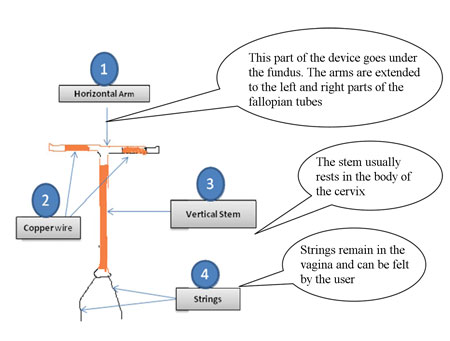Self-Assessment Questions (SAQs) for Study Session 7
Now that you have completed this study session, you can assess how well you have achieved its Learning Outcomes by answering these questions. Write your answers in your Study Diary and discuss them with your Tutor at the next Study Support Meeting. You can check your answers with the Notes on the Self-Assessment Questions at the end of this Module.
SAQ 7.1 (tests Learning Outcomes 7.1 and 7.2)
It is important to understand the parts of an IUCD. Make your own drawing of a Copper T IUCD, correctly labelling its parts and explaining its location in the uterus.
Answer
Your hand-drawn Copper T IUCD drawing should look something like this. See Figure 7.3.
SAQ 7.2 (tests Learning Outcome 7.3)
You have learnt that IUCDs are very effective in preventing pregnancies. Note down at least two ways in which a copper-bearing IUCD can interfere with fertilisation.
Answer
A copper-bearing IUCD can interfere with fertilisation in two main ways:
- The copper slows down the movement of sperm within the woman’s uterus to prevent sperm from reaching the fallopian tubes and fertilising the egg.
- The device can stimulate a strong reaction in the wall of the uterus, which prevents implantation of the egg even if it is fertilised.
SAQ 7.3 (tests Learning Outcomes 7.1, 7.2, 7.3, 7.4, 7.5 and 7.7)
Which of the following statements are false? In each case explain why it is incorrect.
A Loops and Copper T IUCDs are quite different in shape and size. Moreover, when compared with T IUCDs, loops are not widely used nowadays.
B The main purpose of the impregnated barium sulfate in an IUCD is that it interferes with fertilisation.
C Copper-bearing IUCDs can lose their effect when inserted into a woman who is taking anti-tuberculosis medication.
D The Copper T is a U-shaped, highly flexible device that any health professional can insert.
E If inserted and placed appropriately, expulsion of the Copper T IUCD is rare.
Answer
A is true. Loops and Copper T IUCDs are quite different in shape and size.
B is false because the main function of impregnated barium sulfate in IUCDs is to illuminate the location of the device in the uterus when an x-ray image is taken. It has nothing to do with fertilisation.
C is false because the copper-bearing IUCD acts locally and has no systemic effect in reacting with other drugs. Therefore it can be safely used as a contraceptive method by a woman who is taking antituberculosis medication.
D is false because in spite of its flexibility, it is not easy to insert a copper T IUCD into the uterus. You need special skills and training to do so. Therefore, health professionals who are not trained in such skills should not insert the device.
E is true. Expulsion of the Copper T IUCD is rare, if inserted and placed appropriately.
SAQ 7.4 (tests Learning Outcome 7.5)
A woman who is currently on oral contraceptives but wants to change her method to an IUCD comes to your health post and asks for information about the advantages of using IUCDs compared with oral contraceptives. What is your response?
Answer
IUCDs have the following advantages compared to oral contraceptives:
- They contain no hormones, so do not cause blood clots and heart attacks. Although it is very rare, oral contraceptives can have these side-effects.
- IUCDs act locally and do not affect other drugs. Therefore, an IUCD can be safely used as an optional contraceptive method by a woman taking anti-tuberculosis and/or anticonvulsion drugs.
- IUCDs can be a good choice for lactating mothers, as they do not affect breastmilk .
SAQ 7.5 (tests Learning Outcomes 7.5, 7.6, 7.7)
What are the advantages of IUCDs compared with oral contraceptives? You may find it helpful to refer back to Study Session 5, which covers the disadvantages and common side-effects of oral contraceptives for comparison.
Draw a table and list the disadvantages and side-effects of oral contraceptives in the left column, and try to match them against the relative advantages of IUCDs in the right column. This will help you to remember them.
Answer
The following table depicts the relative advantages of IUCDs compared with oral contraceptives.
| Disadvantages/side effects of oral contraceptives | Relative advantages of IUCDs |
|---|---|
|
|
SAQ 7.6 (tests Learning Outcome 7.6)
There are several groups of women who cannot use IUCDs at all. List them and explain why.
Answer
The following is a list of groups of women who cannot use IUCDs at all:
- Women with active PID cannot use IUCDs as they can worsen any pelvic infection as a result of microbiological contamination during insertion.
- Women who are known to be pregnant should not use IUCDs because they can cause toxicity to the fetus, which may result in abortion.
- Women who are suffering from undiagnosed irregular genital tract bleeding must consult a doctor before using an IUCD, as the bleeding could be due to uterine cancer. Using an IUCD with this condition can worsen the bleeding.
- Women who are known to be allergic to any constituent of the device should avoid using an IUCD because it may result in an undesirable health problem.
Summary of Study Session 7

